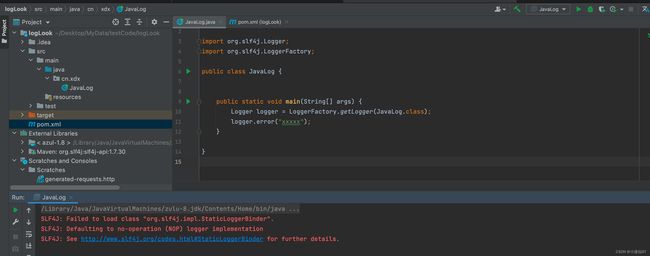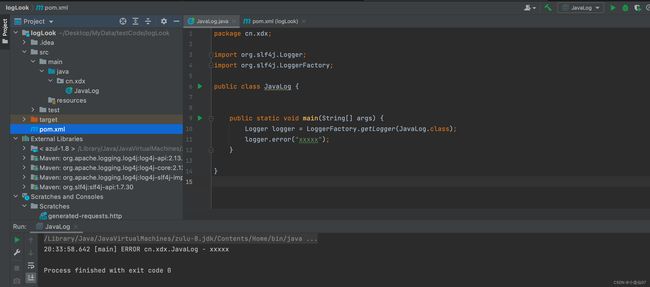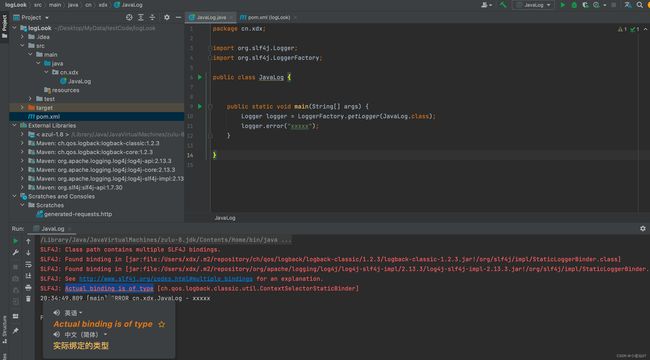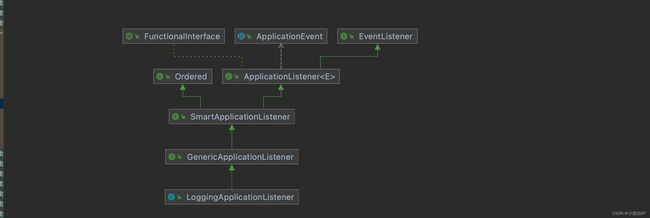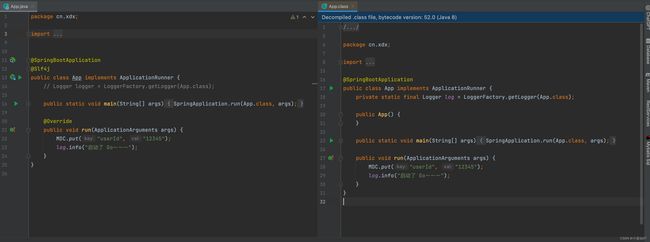Java日志源码详解,SpringBoot日志 slf4j、logback、log4j
- 日志视频讲解—上
- 日志视频讲解—下
- 学习文档集合
一、前提
在Java中说起日志,定听过这样几个名词:slf4j、logback、log4j,在正式开始之前,先了解几个简单的概念
- slf4j、logback、log4j 的作者都是一个人
- slf4j 的全名是 Simple Logging Facade for Java,它只是一个门面,可以简单理解是一个接口,具体实现由logback和log4j去实现
- logback、log4j 都是出自一个人,而logback是后面出来的,那不言而喻,一个人做了两个东西,肯定是对一个东西不是很满意,实际上logback也比log4j更有优势
- SpringBoot项目默认的日志就是用 logback,从侧面体现了它确有优势
二、原生Java使用日志
1、证明 slf4j 是一个门面
在一个基本的Java项目(只引入JDK)要想打印日志,只需要引入 slf4j 和 它的实现类基本包就可以了。

<project xmlns="http://maven.apache.org/POM/4.0.0"
xmlns:xsi="http://www.w3.org/2001/XMLSchema-instance"
xsi:schemaLocation="http://maven.apache.org/POM/4.0.0 http://maven.apache.org/xsd/maven-4.0.0.xsd">
<modelVersion>4.0.0modelVersion>
<groupId>cn.xdxgroupId>
<artifactId>logLookartifactId>
<version>1.0-SNAPSHOTversion>
<properties>
<maven.compiler.source>8maven.compiler.source>
<maven.compiler.target>8maven.compiler.target>
properties>
<dependencies>
<dependency>
<groupId>org.slf4jgroupId>
<artifactId>slf4j-apiartifactId>
<version>1.7.30version>
dependency>
<dependency>
<groupId>ch.qos.logbackgroupId>
<artifactId>logback-classicartifactId>
<version>1.2.3version>
dependency>
<dependency>
<groupId>org.apache.logging.log4jgroupId>
<artifactId>log4j-slf4j-implartifactId>
<version>2.13.3version>
<scope>compilescope>
dependency>
<dependency>
<groupId>org.apache.logging.log4jgroupId>
<artifactId>log4j-coreartifactId>
<version>2.13.3version>
<scope>compilescope>
dependency>
dependencies>
project>
1-1、空实现-证明
去掉pom文件中的 log4j和logback的依赖,运行代码异常如下:找不到实现类
Failed to load class “org.slf4j.impl.StaticLoggerBinder” 注意这个包名后面会用到
1-2、独自logback、独自 log4j、一起使用
单独使用logback——只需要注释log4j的依赖。正常运行

单独使用 log4j——只需要注释logback的依赖。正常运行
一起使用——会提示找到多个实现类,最终按照pom文件的引用依赖顺序选择一个(可以试试把log4j依赖放前面)
2、Logger工厂创建 (ILoggerFactory)重要
Logger logger = LoggerFactory.getLogger(JavaLog.class);
public static Logger getLogger(String name) {
ILoggerFactory iLoggerFactory = getILoggerFactory();
return iLoggerFactory.getLogger(name);
}
- 创建Logger之前,先创建了一个工厂,再基于这个工厂来创建具体的Logger。(ILoggerFactory)
- 工厂就是来创建对象的,刚刚我们看到logback和log4j不同的实现,其本质就是不同的工厂创建的不同的对象。
2-1、工厂创建的开始
- INITIALIZATION_STATE 是当前工厂的状态,根据不同的状态执行不同的代码,默认是 UNINITIALIZED 未初始化。
StaticLoggerBinder.getSingleton().getLoggerFactory();初始化好就会创建工厂类,这行就是返回创建好的工厂。
public static ILoggerFactory getILoggerFactory() {
// 默认未初始化状态
if (INITIALIZATION_STATE == UNINITIALIZED) {
synchronized (LoggerFactory.class) {
if (INITIALIZATION_STATE == UNINITIALIZED) {
// 正在初始化
INITIALIZATION_STATE = ONGOING_INITIALIZATION;
// 初始化代码
performInitialization();
}
}
}
switch (INITIALIZATION_STATE) {
case SUCCESSFUL_INITIALIZATION: // 初始化成功所执行的代码
return StaticLoggerBinder.getSingleton().getLoggerFactory();
case NOP_FALLBACK_INITIALIZATION:
return NOP_FALLBACK_FACTORY;
case FAILED_INITIALIZATION:
throw new IllegalStateException(UNSUCCESSFUL_INIT_MSG);
case ONGOING_INITIALIZATION:
// support re-entrant behavior.
// See also http://jira.qos.ch/browse/SLF4J-97
return SUBST_FACTORY;
}
throw new IllegalStateException("Unreachable code");
}
2-2、绑定真正的工厂类
private final static void performInitialization() {
bind();
if (INITIALIZATION_STATE == SUCCESSFUL_INITIALIZATION) {
versionSanityCheck();
}
}
private final static void bind() {
try {
Set<URL> staticLoggerBinderPathSet = null;
// 判断是否是安卓,Java不是安卓,所以会执行
// 这个if中的代码没有实际的作用【作用就是如果你有多个工厂实现,就打印日志提醒你】
if (!isAndroid()) {
// 找到当前可以被绑定的工厂
staticLoggerBinderPathSet = findPossibleStaticLoggerBinderPathSet();
// 如果找到多个就打印日志,上面看到的多个绑定日志就是这里打印的
reportMultipleBindingAmbiguity(staticLoggerBinderPathSet);
}
// 初始化LoggerFactory,这里就是按照顺序读取一个工厂bean
StaticLoggerBinder.getSingleton();
// 设置初始化状态为成功
INITIALIZATION_STATE = SUCCESSFUL_INITIALIZATION;
reportActualBinding(staticLoggerBinderPathSet);
} catch (NoClassDefFoundError ncde) {
// 异常处理
} catch (java.lang.NoSuchMethodError nsme) {
// 异常处理
} catch (Exception e) {
// 异常处理
} finally {
postBindCleanUp();
}
}
2-3、slf4j 如何做到不同实现的随机切换
其实很简单,它里面写死了真正工厂类的权限定名:org.slf4j.impl.StaticLoggerBinder,也就是谁要使用slf4j这个门面,谁就要写一个这个类,用这个类去生成工厂。
##### 2-3-1、找到多个实现类,怎么做提示?
上面验证,当引入log4j和logback的时候,会提示有多个实现类,它是怎么做的呢?
就是用了一个写死的完整的类权限定名,如果加载到多个,就返回多个,就打印日志。
private static String STATIC_LOGGER_BINDER_PATH = "org/slf4j/impl/StaticLoggerBinder.class";
static Set<URL> findPossibleStaticLoggerBinderPathSet() {
// use Set instead of list in order to deal with bug #138
// LinkedHashSet appropriate here because it preserves insertion order
// during iteration
Set<URL> staticLoggerBinderPathSet = new LinkedHashSet<URL>();
try {
ClassLoader loggerFactoryClassLoader = LoggerFactory.class.getClassLoader();
Enumeration<URL> paths;
if (loggerFactoryClassLoader == null) {
paths = ClassLoader.getSystemResources(STATIC_LOGGER_BINDER_PATH);
} else {
paths = loggerFactoryClassLoader.getResources(STATIC_LOGGER_BINDER_PATH);
}
while (paths.hasMoreElements()) {
URL path = paths.nextElement();
staticLoggerBinderPathSet.add(path);
}
} catch (IOException ioe) {
Util.report("Error getting resources from path", ioe);
}
return staticLoggerBinderPathSet;
}
private static void reportMultipleBindingAmbiguity(Set<URL> binderPathSet) {
if (isAmbiguousStaticLoggerBinderPathSet(binderPathSet)) {
Util.report("Class path contains multiple SLF4J bindings.");
for (URL path : binderPathSet) {
Util.report("Found binding in [" + path + "]");
}
Util.report("See " + MULTIPLE_BINDINGS_URL + " for an explanation.");
}
}
private static boolean isAmbiguousStaticLoggerBinderPathSet(Set<URL> binderPathSet) {
return binderPathSet.size() > 1;
}
2-3-2、如果引入多个实现类,最终用哪个呢?
答案是谁先引入就用谁,在绑定的时候,会有下面的代码,这代码就是去初始化工厂类。
现在已经很明了它是怎么选择实现类了,而log4j和logback都是同一个作者,作者说logback比log4j好,那我们后续对日志的解读当然都是基于logback来了。
StaticLoggerBinder.getSingleton();
public static StaticLoggerBinder getSingleton() {
return SINGLETON;
}
private static StaticLoggerBinder SINGLETON = new StaticLoggerBinder();
private StaticLoggerBinder() {
defaultLoggerContext.setName(CoreConstants.DEFAULT_CONTEXT_NAME);
}
private LoggerContext defaultLoggerContext = new LoggerContext();
2-4、工厂类的初始化
- 创建了工厂类class LoggerContext implements ILoggerFactory
- 创建了根Logger,并为其设置了默认的配置(这个根Logger是干嘛的后面再说)
-
- 默认的level:DEBUG
-
- 默认的layout:%d{HH:mm:ss.SSS} [%thread] %-5level %logger{36} - %msg%n
-
- 默认的appende:ConsoleAppender
StaticLoggerBinder.getSingleton();
public static StaticLoggerBinder getSingleton() {
return SINGLETON;
}
private static StaticLoggerBinder SINGLETON = new StaticLoggerBinder();
static {
SINGLETON.init();
}
StaticLoggerBinder 里面有个静态代码块,里面执行了 init 方法。
// 使用logback的工厂是 LoggerContext
private LoggerContext defaultLoggerContext = new LoggerContext();
void init() {
try {
try {
// 创建默认的工厂,并进行初始化
new ContextInitializer(defaultLoggerContext).autoConfig();
} catch (JoranException je) {
Util.report("Failed to auto configure default logger context", je);
}
// logback-292
if (!StatusUtil.contextHasStatusListener(defaultLoggerContext)) {
StatusPrinter.printInCaseOfErrorsOrWarnings(defaultLoggerContext);
}
// 把当前的工厂放入上下午绑定器里面
contextSelectorBinder.init(defaultLoggerContext, KEY);
initialized = true;
} catch (Exception t) { // see LOGBACK-1159
Util.report("Failed to instantiate [" + LoggerContext.class.getName() + "]", t);
}
}
创建根Logger,设置默认的等级为 DEBUG
public LoggerContext() {
super();
this.loggerCache = new ConcurrentHashMap<String, Logger>();
this.loggerContextRemoteView = new LoggerContextVO(this);
this.root = new Logger(Logger.ROOT_LOGGER_NAME, null, this);
this.root.setLevel(Level.DEBUG);
loggerCache.put(Logger.ROOT_LOGGER_NAME, root);
initEvaluatorMap();
size = 1;
this.frameworkPackages = new ArrayList<String>();
}
设置根Logger的 Layout和Appender
public void autoConfig() throws JoranException {
StatusListenerConfigHelper.installIfAsked(loggerContext);
URL url = findURLOfDefaultConfigurationFile(true);
if (url != null) {
configureByResource(url);
} else {
Configurator c = EnvUtil.loadFromServiceLoader(Configurator.class);
if (c != null) {
try {
c.setContext(loggerContext);
c.configure(loggerContext);
} catch (Exception e) {
throw new LogbackException(String.format("Failed to initialize Configurator: %s using ServiceLoader", c != null ? c.getClass()
.getCanonicalName() : "null"), e);
}
} else {
BasicConfigurator basicConfigurator = new BasicConfigurator();
basicConfigurator.setContext(loggerContext);
basicConfigurator.configure(loggerContext);
}
}
}
public void configure(LoggerContext lc) {
addInfo("Setting up default configuration.");
ConsoleAppender<ILoggingEvent> ca = new ConsoleAppender<ILoggingEvent>();
ca.setContext(lc);
ca.setName("console");
LayoutWrappingEncoder<ILoggingEvent> encoder = new LayoutWrappingEncoder<ILoggingEvent>();
encoder.setContext(lc);
// same as
// PatternLayout layout = new PatternLayout();
// layout.setPattern("%d{HH:mm:ss.SSS} [%thread] %-5level %logger{36} - %msg%n");
TTLLLayout layout = new TTLLLayout();
layout.setContext(lc);
layout.start();
encoder.setLayout(layout);
ca.setEncoder(encoder);
ca.start();
Logger rootLogger = lc.getLogger(Logger.ROOT_LOGGER_NAME);
rootLogger.addAppender(ca);
}
// 这里可以先看看,只有 ROOT的Logger才有这个 Appender,数据是存在 aai 中
public synchronized void addAppender(Appender<ILoggingEvent> newAppender) {
if (aai == null) {
aai = new AppenderAttachableImpl<ILoggingEvent>();
}
aai.addAppender(newAppender);
}
3、Logger 创建
上面已经得出来最终的工厂类是 LoggerContext,现在只需要看它里面的 getLogger方法是如何创建Logger的即可。
Logger的创建并不像我们想象的那样每个类创建一个,它是有子父级概念的,和我们的包路径一样的结构,比如类权限定名为 cn.xdx.JavaLog,则会创建4个Logger,分别是 ROOT、cn、cn.xdx、cn.xdx.JavaLog,并且它是一个树结构,ROOT节点的字节点包含了下面的三个。
@Override
public final Logger getLogger(final String name) {
if (name == null) {
throw new IllegalArgumentException("name argument cannot be null");
}
// 判断是不是获取 根 Logger
if (Logger.ROOT_LOGGER_NAME.equalsIgnoreCase(name)) {
return root;
}
int i = 0;
Logger logger = root;
// 判断当前Logger 是否已经创建过了,如果存在就返回
Logger childLogger = (Logger) loggerCache.get(name);
// if we have the child, then let us return it without wasting time
if (childLogger != null) {
return childLogger;
}
String childName;
while (true) {
// 用【.】去切割权限定名,h就是返回有几层
int h = LoggerNameUtil.getSeparatorIndexOf(name, i);
// 获取当前层级
if (h == -1) {
childName = name;
} else {
childName = name.substring(0, h);
}
i = h + 1;
// 从根节点开始便利,直到找到了当前的Logger
synchronized (logger) {
childLogger = logger.getChildByName(childName);
if (childLogger == null) {
// 创建 Logger
childLogger = logger.createChildByName(childName);
// 放入缓存
loggerCache.put(childName, childLogger);
incSize();
}
}
logger = childLogger;
if (h == -1) {
return childLogger;
}
}
}
新Logger的创建
Logger createChildByName(final String childName) {
int i_index = LoggerNameUtil.getSeparatorIndexOf(childName, this.name.length() + 1);
if (i_index != -1) {
throw new IllegalArgumentException("For logger [" + this.name + "] child name [" + childName
+ " passed as parameter, may not include '.' after index" + (this.name.length() + 1));
}
if (childrenList == null) {
childrenList = new CopyOnWriteArrayList<Logger>();
}
Logger childLogger;
childLogger = new Logger(childName, this, this.loggerContext);
childrenList.add(childLogger);
childLogger.effectiveLevelInt = this.effectiveLevelInt;
return childLogger;
}
Logger(String name, Logger parent, LoggerContext loggerContext) {
this.name = name;
this.parent = parent;
this.loggerContext = loggerContext;
}
4、Logger 输出到控制台的过程
public static void main(String[] args) {
Logger logger = LoggerFactory.getLogger(JavaLog.class);
logger.error("xxxxx");
}
上面已经得到了Logger的实现类 ch.qos.logback.classic.Logger,现在就来看看这个 logger.error 是如何输出到控制的。
4-1、方法的重载
每种级别的方法参数都有很多,所以都会做参数不同的方法重载。
public void error(String msg) {
filterAndLog_0_Or3Plus(FQCN, null, Level.ERROR, msg, null, null);
}
private void filterAndLog_0_Or3Plus(final String localFQCN, final Marker marker, final Level level, final String msg, final Object[] params,
final Throwable t) {
// 循环去运行过滤器
final FilterReply decision = loggerContext.getTurboFilterChainDecision_0_3OrMore(marker, this, level, msg, params, t);
// 如果状态是 中性,就判断当前是否要判断过滤级别
if (decision == FilterReply.NEUTRAL) {
if (effectiveLevelInt > level.levelInt) {
return;
}
} else if (decision == FilterReply.DENY) {
return;
}
buildLoggingEventAndAppend(localFQCN, marker, level, msg, params, t);
}
4-2、过滤掉不想输出的日志
有两种情况,即便是调用了日志打印方法也不会输出日志
- 被过滤器过滤了
- 日志的级别过低(比如我们设置的是error级别,但是你打印 info级别的就行)
final FilterReply getTurboFilterChainDecision_0_3OrMore(final Marker marker, final Logger logger, final Level level, final String format,
final Object[] params, final Throwable t) {
// 如果没有过滤器就返回 中性状态
if (turboFilterList.size() == 0) {
return FilterReply.NEUTRAL;
}
// 循环去运行所有过滤器
return turboFilterList.getTurboFilterChainDecision(marker, logger, level, format, params, t);
}
自定义过滤器
public class MyLogBackFilter extends TurboFilter {
@Override
public FilterReply decide(Marker marker, Logger logger, Level level, String format, Object[] params, Throwable t) {
System.out.println("kkkkkk");
return FilterReply.ACCEPT;
}
}
public static void main(String[] args) {
Logger logger = LoggerFactory.getLogger(JavaLog.class);
LoggerContext loggerContext = (LoggerContext)LoggerFactory.getILoggerFactory();
loggerContext.addTurboFilter(new MyLogBackFilter());
logger.error("xxxxx");
}
4-3、构建日志事件
其实就是组装这次日志打印的信息
private void buildLoggingEventAndAppend(final String localFQCN, final Marker marker, final Level level, final String msg, final Object[] params,
final Throwable t) {
LoggingEvent le = new LoggingEvent(localFQCN, this, level, msg, t, params);
le.setMarker(marker);
callAppenders(le);
}
public LoggingEvent(String fqcn, Logger logger, Level level, String message, Throwable throwable, Object[] argArray) {
this.fqnOfLoggerClass = fqcn;
this.loggerName = logger.getName();
this.loggerContext = logger.getLoggerContext();
this.loggerContextVO = loggerContext.getLoggerContextRemoteView();
this.level = level;
this.message = message;
this.argumentArray = argArray;
if (throwable == null) {
throwable = extractThrowableAnRearrangeArguments(argArray);
}
if (throwable != null) {
this.throwableProxy = new ThrowableProxy(throwable);
LoggerContext lc = logger.getLoggerContext();
if (lc.isPackagingDataEnabled()) {
this.throwableProxy.calculatePackagingData();
}
}
timeStamp = System.currentTimeMillis();
}
4-4、日志输出
- 这里面的调用链很长,但逻辑都很简单,就直接把代码给出吧
- doAppend 方法之后就是一些正常的操作,就不再截图了,可以自行去看(ROOT 里面默认的是ConsoleAppender)
public void callAppenders(ILoggingEvent event) {
int writes = 0;
// 循环便利每个层级的Logger,如果当前Logger 有Appender 就输出
// 上面创建 Logger的时候,其实就知道了只有ROOT_Logger 才有Appender,所里这里也是等到ROOT才会输出
for (Logger l = this; l != null; l = l.parent) {
writes += l.appendLoopOnAppenders(event);
// 这个参数默认都是 true 不用管
if (!l.additive) {
break;
}
}
// No appenders in hierarchy
if (writes == 0) {
loggerContext.noAppenderDefinedWarning(this);
}
}
private int appendLoopOnAppenders(ILoggingEvent event) {
if (aai != null) {
return aai.appendLoopOnAppenders(event);
} else {
return 0;
}
}
// ROOT 里面默认的是ConsoleAppender
public int appendLoopOnAppenders(E e) {
int size = 0;
Appender<E>[] appenderArray = (Appender[])this.appenderList.asTypedArray();
int len = appenderArray.length;
for(int i = 0; i < len; ++i) {
appenderArray[i].doAppend(e);
++size;
}
return size;
}
4-4-1、日志格式化
上面看到最终输出日志的是ROOT_Logger,而ROOT中的 layout是 TTLLLayout,日志格式化的时候会调用doLayout 方法
@Override
public String doLayout(ILoggingEvent event) {
if (!isStarted()) {
return CoreConstants.EMPTY_STRING;
}
StringBuilder sb = new StringBuilder();
long timestamp = event.getTimeStamp();
sb.append(cachingDateFormatter.format(timestamp));
sb.append(" [");
sb.append(event.getThreadName());
sb.append("] ");
sb.append(event.getLevel().toString());
sb.append(" ");
sb.append(event.getLoggerName());
sb.append(" - ");
sb.append(event.getFormattedMessage());
sb.append(CoreConstants.LINE_SEPARATOR);
IThrowableProxy tp = event.getThrowableProxy();
if (tp != null) {
String stackTrace = tpc.convert(event);
sb.append(stackTrace);
}
return sb.toString();
}
三、SpringBoot中的日志
使用SpringBoot就要引入相关的pom文件,这里需要把pom文件替换成下面的
<groupId>cn.xdx</groupId>
<artifactId>logLook</artifactId>
<version>1.0-SNAPSHOT</version>
<properties>
<maven.compiler.source>8</maven.compiler.source>
<maven.compiler.target>8</maven.compiler.target>
</properties>
<parent>
<groupId>org.springframework.boot</groupId>
<artifactId>spring-boot-starter-parent</artifactId>
<version>2.4.5</version>
<relativePath/>
</parent>
<dependencies>
<!--Use undertow, 设置服务器,和日志没关系哈-->
<dependency>
<groupId>org.springframework.boot</groupId>
<artifactId>spring-boot-starter-undertow</artifactId>
</dependency>
<dependency>
<groupId>org.springframework.boot</groupId>
<artifactId>spring-boot-starter-web</artifactId>
<exclusions>
<exclusion>
<groupId>org.springframework.boot</groupId>
<artifactId>spring-boot-starter-tomcat</artifactId>
</exclusion>
</exclusions>
</dependency>
</dependencies>
启动服务,使用日志功能,发现在不做任何配置的时候,它默认使用的是 logback打印
1、如何加载、选择日志工厂
1-1、前置:SpringBoot 自动加载流程
在SpringBoot项目启动的时候会自动做很多的操作,这里需要了解两点
- SpringFactoriesLoader 这个类会去加载所有 META-INF/spring.factories 文件,loadFactoryNames这个方法就是通过name找到所有spring.factories文件中对应的类。
- ApplicationListener 是一个接口,SpringBoot项目在启动的每个阶段都会投递事件到 onApplicationEvent 方法中。
在SpringBoot的 spring.factories 下有三个工厂构造器,启动的时候会把它们三个都加载进去(按照顺序加载第一个就是 logback)
在SpringBoot的中有一个 LoggingApplicationListener,它的继承关系如下,所以它本质上是一个ApplicationListener,并且重写了onApplicationEvent方法。
1-2、logback和log4j切换、默认的为何是logback
在原始日志中,知道LoggerFactory的实现类是取决于引用了什么包。而在SpringBoot项目中它默认就引入了 logback的包,所以它默认是用 logback。
如果在SpringBoot中想切换成 log4j,原理也是一样,去除logback的包,引入log4j
<dependency>
<groupId>org.springframework.bootgroupId>
<artifactId>spring-boot-starter-webartifactId>
<exclusions>
<exclusion>
<groupId>org.springframework.bootgroupId>
<artifactId>spring-boot-starter-tomcatartifactId>
exclusion>
<exclusion>
<groupId>org.springframework.bootgroupId>
<artifactId>spring-boot-starter-loggingartifactId>
exclusion>
exclusions>
dependency>
<dependency>
<groupId>org.springframework.bootgroupId>
<artifactId>spring-boot-starter-log4jartifactId>
<version>1.3.8.RELEASEversion>
dependency>
1-3、准备:初始化LoggerFactory
其实在SpringBoot中 LoggerFactory的构建也是基于上面原生的方式,只不过在原生方式创建了 LoggerFactory之后,SpringBoot再基于自己的配置,去修改、填充LoggerFactory中配置。
- 基于原生方式构建出 LoggerFactory
- SpringBoot基于启动阶段来做初始化(LoggingApplicationListener)
public void onApplicationEvent(ApplicationEvent event) {
// 启动时候的事件 —— 进行日志前置初始化
if (event instanceof ApplicationStartingEvent) {
this.onApplicationStartingEvent((ApplicationStartingEvent)event);
}
// 环境变量准备好的事件 —— 进行日志初始化
else if (event instanceof ApplicationEnvironmentPreparedEvent) {
this.onApplicationEnvironmentPreparedEvent((ApplicationEnvironmentPreparedEvent)event);
}
// 全部启动好之后的事件 —— 暂不关注
else if (event instanceof ApplicationPreparedEvent) {
this.onApplicationPreparedEvent((ApplicationPreparedEvent)event);
} else if (event instanceof ContextClosedEvent && ((ContextClosedEvent)event).getApplicationContext().getParent() == null) {
this.onContextClosedEvent();
} else if (event instanceof ApplicationFailedEvent) {
this.onApplicationFailedEvent();
}
}
1-4、前置:初始化LoggerFactory
- 找到 loggingSystem,这个就是SpringBoot对各种日志实现的包装,对应的包装就是对应的实现类
- 初始化前置,这里其实是一个空实现,如果有必要可以实现这个接口做一些操作
private void onApplicationStartingEvent(ApplicationStartingEvent event) {
this.loggingSystem = LoggingSystem.get(event.getSpringApplication().getClassLoader());
this.loggingSystem.beforeInitialize();
}
private static final LoggingSystemFactory SYSTEM_FACTORY = LoggingSystemFactory.fromSpringFactories();
public static LoggingSystem get(ClassLoader classLoader) {
String loggingSystemClassName = System.getProperty(SYSTEM_PROPERTY);
// 这里默认为 null
if (StringUtils.hasLength(loggingSystemClassName)) {
return (LoggingSystem)("none".equals(loggingSystemClassName) ? new LoggingSystem.NoOpLoggingSystem() : get(classLoader, loggingSystemClassName));
} else {
// 走这个
LoggingSystem loggingSystem = SYSTEM_FACTORY.getLoggingSystem(classLoader);
Assert.state(loggingSystem != null, "No suitable logging system located");
return loggingSystem;
}
}
public interface LoggingSystemFactory {
LoggingSystem getLoggingSystem(ClassLoader classLoader);
static LoggingSystemFactory fromSpringFactories() {
// 创建一个 DelegatingLoggingSystemFactory
return new DelegatingLoggingSystemFactory((classLoader) -> {
// 这里就是前面说的,通过name去获取 spring.factories 对应的数据,有兴趣自己去看看
// 这里获取的数据会按照 @Order 排序,但是这三个实现类的 @Order是一样的,所以是默认顺序
return SpringFactoriesLoader.loadFactories(LoggingSystemFactory.class, classLoader);
});
}
}
循环去遍历每一个factory,找到了就返回,其本质也是看当前项目下有没有具体的类
public LoggingSystem getLoggingSystem(ClassLoader classLoader) {
List<LoggingSystemFactory> delegates = this.delegates != null ? (List)this.delegates.apply(classLoader) : null;
if (delegates != null) {
Iterator var3 = delegates.iterator();
while(var3.hasNext()) {
LoggingSystemFactory delegate = (LoggingSystemFactory)var3.next();
LoggingSystem loggingSystem = delegate.getLoggingSystem(classLoader);
if (loggingSystem != null) {
return loggingSystem;
}
}
}
return null;
}
logback和log4j的实现,就是判断isPresent中的这个权限定名有没有。
@Order(2147483647)
public static class Factory implements LoggingSystemFactory {
private static final boolean PRESENT = ClassUtils.isPresent("ch.qos.logback.core.Appender", LogbackLoggingSystem.Factory.class.getClassLoader());
public Factory() {
}
public LoggingSystem getLoggingSystem(ClassLoader classLoader) {
return PRESENT ? new LogbackLoggingSystem(classLoader) : null;
}
}
@Order(2147483647)
public static class Factory implements LoggingSystemFactory {
private static final boolean PRESENT = ClassUtils.isPresent("org.apache.logging.log4j.core.impl.Log4jContextFactory", Log4J2LoggingSystem.Factory.class.getClassLoader());
public Factory() {
}
public LoggingSystem getLoggingSystem(ClassLoader classLoader) {
return PRESENT ? new Log4J2LoggingSystem(classLoader) : null;
}
}
1-5、开始:初始化LoggerFactory
前面已经创建好了LoggerFactory > LoggerContext,这里的初始化是对LoggerContext里面的一些数据进行赋值,主要是读取配置文件 自定义的 logback.xml 和 application
private void onApplicationEnvironmentPreparedEvent(ApplicationEnvironmentPreparedEvent event) {
// 在前置里面已经生成了 loggingSystem,准确来说是它的实现类 LogbackLoggingSystem
if (this.loggingSystem == null) {
this.loggingSystem = LoggingSystem.get(event.getSpringApplication().getClassLoader());
}
// 初始化就是读取配置文件中的信息,来重新填充LoggerFactory——它的实现类 LoggerContext
initialize(event.getEnvironment(), event.getSpringApplication().getClassLoader());
}
如果你配置过logback.xml,那你肯定在application里面配置过它的位置logging.config: classpath:logback.xml
protected void initialize(ConfigurableEnvironment environment, ClassLoader classLoader) {
// ...
initializeSystem(environment, this.loggingSystem, this.logFile);
// ...
}
public static final String CONFIG_PROPERTY = "logging.config";
private void initializeSystem(ConfigurableEnvironment environment, LoggingSystem system, LogFile logFile) {
String logConfig = StringUtils.trimWhitespace(environment.getProperty(CONFIG_PROPERTY));
try {
LoggingInitializationContext initializationContext = new LoggingInitializationContext(environment);
if (ignoreLogConfig(logConfig)) {
system.initialize(initializationContext, null, logFile);
}
else {
system.initialize(initializationContext, logConfig, logFile);
}
}
catch (Exception ex) {
// ...
}
}
这里用的是 logback,所以最终是:org.springframework.boot.logging.logback.LogbackLoggingSystem#initialize
@Override
public void initialize(LoggingInitializationContext initializationContext, String configLocation, LogFile logFile) {
LoggerContext loggerContext = getLoggerContext();
if (isAlreadyInitialized(loggerContext)) {
return;
}
super.initialize(initializationContext, configLocation, logFile);
loggerContext.getTurboFilterList().remove(FILTER);
markAsInitialized(loggerContext);
if (StringUtils.hasText(System.getProperty(CONFIGURATION_FILE_PROPERTY))) {
getLogger(LogbackLoggingSystem.class.getName()).warn("Ignoring '" + CONFIGURATION_FILE_PROPERTY
+ "' system property. Please use 'logging.config' instead.");
}
}
2、如何解析配置信息、自定义配置信息
在读取配置文件的时候无非就几种情况,既然有多种情况,那肯定是有一个优先级的——即下面的排序
- 指定自己的配置文件 (logging.config: classpath:logback.xml)
- 默认读取的配置文件,本质上和【1】一样,只是文件的位置不同
-
- logback自己的默认配置文件 (“logback-test.groovy”, “logback-test.xml”, “logback.groovy”, “logback.xml”)
-
- 在Spring中 logback默认的配置文件(“logback-test-spring.groovy”, “logback-test-spring.xml”, “logback.groovy”, “logback-spring.xml”)
- 使用 application 配置
- 没有任何配置文件,默认策略
这也就是为什么说logback的在SpringBoot中的默认配置文件是 logback-spring.xml, 因为其它几个后缀基本上不会有。
从代码角度来看的logback日志配置也可以看成是:
- 读取 xml 配置
- 读取 application 配置
org.springframework.boot.logging.AbstractLoggingSystem#initialize
public void initialize(LoggingInitializationContext initializationContext, String configLocation, LogFile logFile) {
// 读取 logging.config 配置的文件 也就是 logback.xml
if (StringUtils.hasLength(configLocation)) {
initializeWithSpecificConfig(initializationContext, configLocation, logFile);
return;
}
// 没有单独的配置文件,读取 默认/application 的配置
initializeWithConventions(initializationContext, logFile);
}
private void initializeWithConventions(LoggingInitializationContext initializationContext, LogFile logFile) {
// 获取logback的默认配置 "logback-test.groovy", "logback-test.xml", "logback.groovy", "logback.xml"
String config = getSelfInitializationConfig();
if (config != null && logFile == null) {
// self initialization has occurred, reinitialize in case of property changes
reinitialize(initializationContext);
return;
}
if (config == null) {
// 获取Srping的默认配置 logback-test-spring.groovy", "logback-test-spring.xml", "logback.groovy", "logback-spring.xml
config = getSpringInitializationConfig();
}
if (config != null) {
// 加载配置
loadConfiguration(initializationContext, config, logFile);
return;
}
// 默认的配置 application
loadDefaults(initializationContext, logFile);
}
2-1、application 读取
先来看没有自定义配置的情况,也就是没有配置 logging.config,也没有读取到logback默认配置和spring中logback的默认配置
org.springframework.boot.logging.logback.LogbackLoggingSystem#loadDefaults
@Override
protected void loadDefaults(LoggingInitializationContext initializationContext, LogFile logFile) {
LoggerContext context = getLoggerContext();
stopAndReset(context);
boolean debug = Boolean.getBoolean("logback.debug");
if (debug) {
StatusListenerConfigHelper.addOnConsoleListenerInstance(context, new OnConsoleStatusListener());
}
Environment environment = initializationContext.getEnvironment();
// 读取 application 中的配置存入 LoggerContext 中
new LogbackLoggingSystemProperties(environment, context::putProperty).apply(logFile);
LogbackConfigurator configurator = debug ? new DebugLogbackConfigurator(context)
: new LogbackConfigurator(context);
// 基于读取到的配置进行配置
new DefaultLogbackConfiguration(initializationContext, logFile).apply(configurator);
context.setPackagingDataEnabled(true);
}
2-1-1、读取 application 配置
这里的代码很清晰,具体如何去解析字段(比如 logging.pattern.console),可以自行去看。
public final void apply(LogFile logFile) {
PropertyResolver resolver = getPropertyResolver();
apply(logFile, resolver);
}
protected void apply(LogFile logFile, PropertyResolver resolver) {
setSystemProperty(resolver, EXCEPTION_CONVERSION_WORD, "logging.exception-conversion-word");
setSystemProperty(PID_KEY, new ApplicationPid().toString());
setSystemProperty(resolver, CONSOLE_LOG_PATTERN, "logging.pattern.console");
setSystemProperty(resolver, CONSOLE_LOG_CHARSET, "logging.charset.console", getDefaultCharset().name());
setSystemProperty(resolver, LOG_DATEFORMAT_PATTERN, "logging.pattern.dateformat");
setSystemProperty(resolver, FILE_LOG_PATTERN, "logging.pattern.file");
setSystemProperty(resolver, FILE_LOG_CHARSET, "logging.charset.file", getDefaultCharset().name());
setSystemProperty(resolver, LOG_LEVEL_PATTERN, "logging.pattern.level");
applyDeprecated(resolver);
if (logFile != null) {
logFile.applyToSystemProperties();
}
}
2-1-2、基于配置文件初始化
在开始之前需要回顾一下logback里面基本内容:
- Appender 日志如何输出,里面包含了输出的格式
- ROOT_log 日志是以包名来建立的层级,根目录是 ROOT
- 所以大部分的配置其实就是围绕上面两个对象
配置的主流程
- 把从application 中读取的内容变成配置
- 基于配置创建 Appender
- 把 Appender 放到 ROOT上
void apply(LogbackConfigurator config) {
synchronized (config.getConfigurationLock()) {
defaults(config);
Appender<ILoggingEvent> consoleAppender = consoleAppender(config);
if (this.logFile != null) {
Appender<ILoggingEvent> fileAppender = fileAppender(config, this.logFile.toString());
config.root(Level.INFO, consoleAppender, fileAppender);
}
else {
config.root(Level.INFO, consoleAppender);
}
}
}
配置文件放入 LoggerContext
private void defaults(LogbackConfigurator config) {
config.conversionRule("clr", ColorConverter.class);
config.conversionRule("wex", WhitespaceThrowableProxyConverter.class);
config.conversionRule("wEx", ExtendedWhitespaceThrowableProxyConverter.class);
config.getContext().putProperty("CONSOLE_LOG_PATTERN", resolve(config, "${CONSOLE_LOG_PATTERN:-"
+ "%clr(%d{${LOG_DATEFORMAT_PATTERN:-yyyy-MM-dd HH:mm:ss.SSS}}){faint} %clr(${LOG_LEVEL_PATTERN:-%5p}) "
+ "%clr(${PID:- }){magenta} %clr(---){faint} %clr([%15.15t]){faint} %clr(%-40.40logger{39}){cyan} "
+ "%clr(:){faint} %m%n${LOG_EXCEPTION_CONVERSION_WORD:-%wEx}}"));
config.getContext().putProperty("CONSOLE_LOG_CHARSET", resolve(config, "${CONSOLE_LOG_CHARSET:-default}"));
config.getContext().putProperty("FILE_LOG_PATTERN", resolve(config, "${FILE_LOG_PATTERN:-"
+ "%d{${LOG_DATEFORMAT_PATTERN:-yyyy-MM-dd HH:mm:ss.SSS}} ${LOG_LEVEL_PATTERN:-%5p} ${PID:- } --- [%t] "
+ "%-40.40logger{39} : %m%n${LOG_EXCEPTION_CONVERSION_WORD:-%wEx}}"));
config.getContext().putProperty("FILE_LOG_CHARSET", resolve(config, "${FILE_LOG_CHARSET:-default}"));
config.logger("org.apache.catalina.startup.DigesterFactory", Level.ERROR);
config.logger("org.apache.catalina.util.LifecycleBase", Level.ERROR);
config.logger("org.apache.coyote.http11.Http11NioProtocol", Level.WARN);
config.logger("org.apache.sshd.common.util.SecurityUtils", Level.WARN);
config.logger("org.apache.tomcat.util.net.NioSelectorPool", Level.WARN);
config.logger("org.eclipse.jetty.util.component.AbstractLifeCycle", Level.ERROR);
config.logger("org.hibernate.validator.internal.util.Version", Level.WARN);
config.logger("org.springframework.boot.actuate.endpoint.jmx", Level.WARN);
}
Appender 创建
private Appender<ILoggingEvent> consoleAppender(LogbackConfigurator config) {
ConsoleAppender<ILoggingEvent> appender = new ConsoleAppender<>();
PatternLayoutEncoder encoder = new PatternLayoutEncoder();
encoder.setPattern(resolve(config, "${CONSOLE_LOG_PATTERN}"));
encoder.setCharset(resolveCharset(config, "${CONSOLE_LOG_CHARSET}"));
config.start(encoder);
appender.setEncoder(encoder);
config.appender("CONSOLE", appender);
return appender;
}
绑定到ROOT
final void root(Level level, Appender<ILoggingEvent>... appenders) {
Logger logger = this.context.getLogger(org.slf4j.Logger.ROOT_LOGGER_NAME);
if (level != null) {
logger.setLevel(level);
}
for (Appender<ILoggingEvent> appender : appenders) {
logger.addAppender(appender);
}
}
2-2、xml 读取
读取文件的规则可以是很多,而且很复杂,我暂时不想去了解这么复杂的逻辑,所以这里只说明入口,不做深入。
不管是怎么得到的xml,最终解析入口都是
protected abstract void loadConfiguration(LoggingInitializationContext initializationContext, String location,
LogFile logFile);
如果配置了 logging.config 那就直接读取到了xml,来看看没有配置的时候怎么读取到的默认文件
private void initializeWithConventions(LoggingInitializationContext initializationContext, LogFile logFile) {
String config = getSelfInitializationConfig();
if (config != null && logFile == null) {
// self initialization has occurred, reinitialize in case of property changes
reinitialize(initializationContext);
return;
}
if (config == null) {
config = getSpringInitializationConfig();
}
if (config != null) {
loadConfiguration(initializationContext, config, logFile);
return;
}
loadDefaults(initializationContext, logFile);
}
// logback默认配置的原因
protected String getSelfInitializationConfig() {
return findConfig(getStandardConfigLocations());
}
@Override
protected String[] getStandardConfigLocations() {
return new String[] { "logback-test.groovy", "logback-test.xml", "logback.groovy", "logback.xml" };
}
// spring默认配置,其实它就是获取logback的默认配置,然后加上一个【-spring】后缀
protected String getSpringInitializationConfig() {
return findConfig(getSpringConfigLocations());
}
protected String[] getSpringConfigLocations() {
String[] locations = getStandardConfigLocations();
for (int i = 0; i < locations.length; i++) {
String extension = StringUtils.getFilenameExtension(locations[i]);
locations[i] = locations[i].substring(0, locations[i].length() - extension.length() - 1) + "-spring."
+ extension;
}
return locations;
}
3、日志的输出
在原生的日志输出里面已经讲解了整个流程,输出过程都是一样的。
K、扩展
1、log读取MDC和application的数据
在日志输出的时候可能会要设置一些自己的参数
- 比如全局 traceId,这种情况可以把它设置到MDC里面去,本质上是放入 ThreadLocal中
- 读取application中的数据比如 spring.application.name
spring:
application:
name: xdx97
logging:
pattern:
console: "[${spring.application.name}] [%X{userId}] [%thread] %-5level %logger{36} - %msg%n"
2、lomback 的 @Slf4j 注解
在项目中大多数时候并不是直接自己注入log类,而是使用 @Slf4j,其本质上是一样的。
但为什么在没有编译之前就可以使用log这个参数,大概率是idea做了什么操作吧,这个等后续有空再研究。
